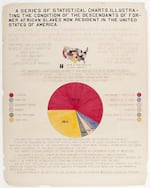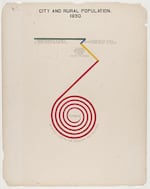Nearly 120 years ago, at the 1900 Exposition Universelle in Paris, a display from the United States put the first post-slavery generation of African Americans on the world stage.
The “Exhibit of American Negroes” was created by an all-black team, led by black scholar and activist W.E.B. Du Bois, in collaboration with Booker T. Washington and Thomas Calloway. It included hundreds of photographs, examples of black literature, and dozens of early, hand-drawn infographics, giving visitors to the 1900 World’s Fair a look at the lives and achievements of African Americans at the turn of the 20th century.
Today, selected reproductions of these works can be seen at the Portland Art Museum.

A graph displayed at the 1900 Exposition Universelle in Paris.
Library of Congress, Prints & Photographs Division
In his 1900 essay "The American Negro at Paris," Du Bois wrote of the display:
“In this exhibit there are, of course, the usual paraphernalia for catching the eye— photographs, models, industrial work, and pictures. But it does not stop here; beneath all this is a carefully thought-out plan, according to which the exhibitors have tried to show:
(a) The history of the American Negro.
(b) His present condition.
(c) His education.
(d) His literature.”
Alex Haynes is one of the curators behind the Portland Art Museum’s special exhibition of Du Bois’ work, and an artist herself. She told OPB’s “Weekend Edition” that an original motivation for the display in Paris was to “showcase the defense of black people and their humanity, right after slavery, and this generation that was basically experiencing terror in the South.”

A graph displayed at the 1900 Exposition Universelle in Paris.
Library of Congress, Prints & Photographs Division
Colorful modernist graphs created by Du Bois and a team of HBCU students provided early, aesthetically striking data visualizations of the economic and social conditions of African Americans. Some of the charts catalogued information about descendants of formerly enslaved Africans nationwide. Others featured information specific to the state of Georgia, which had a large black population at the time, and was the home of Du Bois’ sociology program at Atlanta University. The graphs showed statistics about black property ownership, occupations, education, newspapers, population shifts and more. Others traced the route of the African slave trade, the changing proportions of enslaved and free Africans in the U.S. throughout the 19th century, and the migration patterns of African Americans throughout the country.

A graph displayed at the 1900 Exposition Universelle in Paris.
Library of Congress, Prints & Photographs Division
The graphs show how “these people have brought themselves up, these people own property, these people are literate, these people have a knowledge and understanding of the world despite being forced into subjugation for hundreds of years,” Haynes said.
They’re also laden with visual symbolism. One graph, showing the valuation of taxable property owned by black Georgians, has “arrows all pointing in at the black circle in the center. There’s a lot of layered meaning to that, in the communication of where importance lies in numbers,” Haynes said.
Also on display in Paris in 1900 (and in Portland in 2019): a variety of photographs depicting black life in the United States. They included portraits of black folks of all ages — Haynes particularly enjoyed curating the portraits of children — as well as snapshots of African Americans in their workplaces, their universities and throughout their communities.

A photograph of elementary schoolchildren displayed at the 1900 Exposition Universelle in Paris.
Library of Congress, Prints & Photographs Division
For Alex Haynes, selecting photographs for the Portland Art Museum’s exhibit was a very personal experience, related to her own efforts to research her family history. While people of European descent can often trace their lineage back centuries, Haynes found herself, “as a black person, running into that inevitable created wall of three generations back, the most you would find is census reports and receipts … having to contend with a lot of history that was erased on purpose.”
She explained that the experience made her value the vivid oral histories and stories shared by her grandparents. And later, “stumbling upon Du Bois and his photographs, and this generation in between really big events, I felt really tethered to having these people in 1900 represent something I didn’t usually get to see, and something I didn’t usually get a chance to connect to,” she said.

A photograph of the bacteriology laboratory at Howard University displayed at the 1900 Exposition Universelle in Paris.
Library of Congress, Prints & Photographs Division
The original exhibit in Paris was a display of black achievement and contributions to American society, in spite of what Du Bois famously referred to in his 1903 book "The Souls of Black Folk" as "the problem of the 20th century … the color line." Haynes described the color line as racial segregation and division between black people and white people in America, and pointed out that the color line still presents itself in different ways in modern society.
As a former Chicagoan, Haynes said that upon moving to the white-majority city of Portland, the lack of diversity and “the different level of understanding of … the impact of having it lacking” was noticeable. So what does she hope modern audiences in the Northwest might take away from seeing Du Bois’ work at the Portland Art Museum? “People lived this experience and people are still living repercussions from this experience. … See outside of yourself, or see outside of a preconceived notion of what it meant to be black in 1900 and what it means to be black now.”
To listen to the entire interview with Alex Haynes, use the audio player at the top of this story.
“Color Line: Black Excellence on the World Stage” is on display at the Portland Art Museum through February 2020. The museum will host a lecture in conjunction with the exhibition, “By Any Means Necessary - Racial Justice and Representation in the Arts,” on the evening of Aug. 8. Photography and graphs from the original exhibit in Paris have also been digitized by the Library of Congress.
